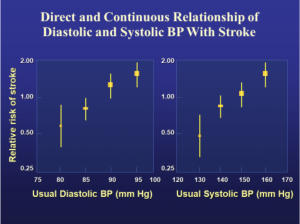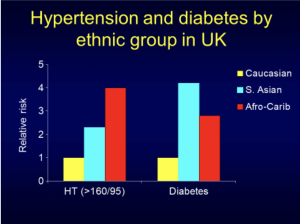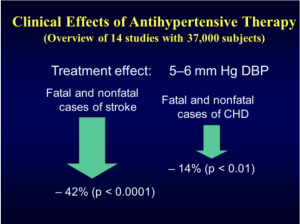Blood pressure tends to increase as we get older and by the age of 60 about half of the population in the UK will have high blood pressure. For many this will start at a much earlier age.
This is really important because for every 12mmHg increase in systolic blood pressure (the top value) or every 5mmHg increase in the diastolic blood pressure (the lower value), the chance of having a stroke is increased by 40% and the chance of having a heart attack is increased by 25%. High blood pressure is often silent, causing no symptoms, so patients don’t know that they have it. That’s why we should regularly check our blood pressure so we can detect if it starts to go up early.
The picture shows that the higher the blood pressure, diastolic or systolic, the higher the risk of stroke. There is a similar relationship with blood pressure and the risk of heart attacks.
The risk of getting high blood pressure or diabetes is very high in our White European (Caucasian) patients. However, it is more than twice as common in our South Asian, and four times as common in our African-Caribbean, patients. For diabetes, the risk in South Asians is four fold and in African-Caribbean patients, three fold.
A huge amount of research has been done on the treatment of hypertension and several studies have shown that for every 5mmHg reduction in diastolic blood pressure, the stroke risk is reduced by about 40% and the heart attack risk by about 15%. For systolic blood pressure every 12mmHg reduction in systolic blood pressure leads to the similar reductions in risk.
It’s because there is such a big benefit from treatment that we are so keen to measure blood pressure and if raised, to treat it very well.
There is some controversy about how low we go when we treat high blood pressure and there are differences between the UK, European and USA guidelines. There is recent evidence that getting the blood pressure to lower levels than we previously aimed for gives even greater protection from heart attacks and strokes. For many patients with hypertension a target blood pressure of 130/80mmHg or lower will be their optimal target blood pressure.
Good blood pressure control can be achieved with exercise, weight loss, reducing alcohol intake and dietary changes in some patients, though others may need medication. It’s important to assess patients individually and advise what the best blood pressure target is for them; one size doesn’t fit all.
LINK TO THE UK GUIDELINES: https://www.nice.org.uk/guidance/ng136




